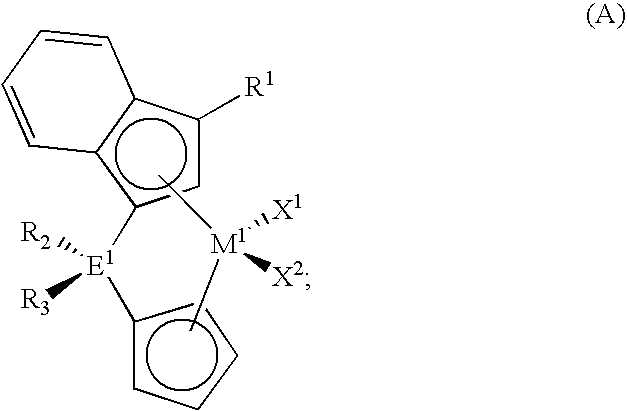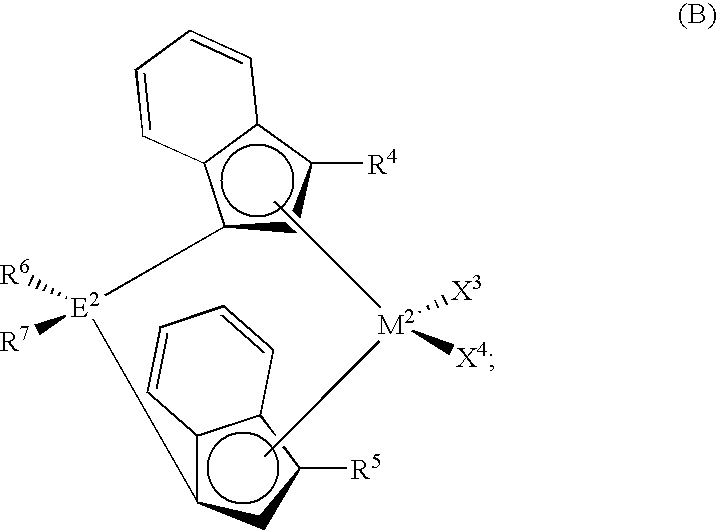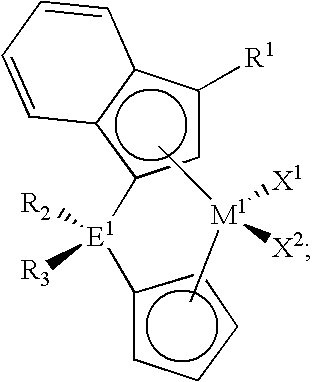Polymerization catalysts for producing high melt index polymers without the use of hydrogen
a polymerization catalyst and high melt index technology, applied in the direction of catalyst activation/preparation, chemical/physical processes, group 4/14 element organic compounds, etc., can solve the problems of reducing the activity of catalysts and the poor activity of such catalyst systems, and achieve the effect of high porosity
- Summary
- Abstract
- Description
- Claims
- Application Information
AI Technical Summary
Benefits of technology
Problems solved by technology
Method used
Image
Examples
example 1
Preparation of Me2CCp(3-PrInd)ZrCl2 (I-1)
[0157]BuLi (10.5 mL, 10 M in hexanes, 105 mmol) was added dropwise to 3-propylindene (15.8 g, 100 mmol) dissolved in THF (200 mL) at −78° C. The resulting mixture was warmed to room temperature and stirred overnight. The PrIndLi solution was added dropwise at 0° C. to the fulvene (13.1 g, 124 mmol) prepared by the method described by Stone and Little in J. Org. Chem. 1984, 49, 1849. The resulting mixture was stirred at room temperature overnight. The reaction was quenched with water. The mixture from above was extracted with Et2O. The resulting organic layer was washed with water and then dried over anhydrous Na2SO4. Removal of the solvent produced a viscous brown oil (crude product). The crude product was purified by column chromatography on silica gel with heptane. The pure ligand (20.2 g, 76.5% yield) was obtained as a yellow oil. [Note: 1) the reaction was not optimized; 2) the product was a mixture of the isomers.]
[0158]The ligand (5.15 ...
example 2
Preparation of Me2CCp(3-ButenylInd)ZrCl2 (I-2)
[0160]Me2CCp(3-ButenylInd)ZrCl2 was prepared in the same manner as I-1 except using butenylindene instead of propylindene. Me2CCp(3-ButenylInd)ZrCl2 (I-2): 1H NMR (300 MHz, CDCl3) δ 7.61 (dt, J=8.7 Hz, 0.9 Hz, 1H), 7.53 (dt, J=8.7 Hz, 0.9 Hz, 1H), 7.28–7.34 (ddd, J=8.7 Hz, 6.6 Hz, 0.9 Hz, 1H), 6.98–7.03 (ddd, J=8.7 Hz, 6.6 Hz, 1.2 Hz, 1H), 6.48–6.57 (m, 2H), 5.76–5.89 (m, 2H), 5.78 (s, 1H), 5.52–5.55 (m, 1H), 4.95–5.07 (m, 2H), 2.85–3.02 (m, 2H), 2.32–2.41 (m, 2H), 2.21 (s, 3H), 1.94 (s, 3H); 13C NMR (75 MHz, CDCl3) δ 137.06, 128.65, 126.07, 125.26, 124.55, 123.64, 122.95, 120.38, 119.92, 119.56, 118.45, 115.12, 112.92, 105.24, 103.69, 99.15, 39.40, 34.61, 27.49, 26.86, 26.12.
example 3
Preparation of Me2CCp(3-Me3SiInd)ZrCl2 (I-3)
[0161]Me2CCp(3-Me3SiInd)ZrCl2 was prepared in the same manner as I-1 except using trimethylsilylindene instead of propylindene. Me2CCp(3-Me3SiInd)ZrCl2 (I-3): 1H NMR (300 MHz, CDCl3) δ 7.79 (dt, J=8.7 Hz, 0.9 Hz, 1H), 7.73 (dt, J=8.7 Hz, 0.9 Hz, 1H), 7.38–7.43 (ddd, J=8.7 Hz, 6.6 Hz, 0.9 Hz, 1H), 7.09–7.15 (ddd, J=8.7 Hz, 6.6 Hz, 1.2 Hz, 1H), 6.48–6.52 (m, 2H), 6.08 (s, 1H), 5.86 (q, J=3 Hz, 1H), 5.75 (q, J=3 Hz, 11H), 2.28 (s, 3H), 2.02 (s, 3H), 0.47 (s, 9H); 13C NMR (75 MHz, CDCl3) δ 136.89, 126.52, 125.84, 125.68, 123.57, 121.40, 121.06, 120.89, 119.16, 118.80, 118.45, 106.79, 105.76, 102.72, 39.46, 26.51, 26.38, 0.25.
PUM
| Property | Measurement | Unit |
|---|---|---|
| time | aaaaa | aaaaa |
| time | aaaaa | aaaaa |
| temperature | aaaaa | aaaaa |
Abstract
Description
Claims
Application Information
 Login to View More
Login to View More - R&D
- Intellectual Property
- Life Sciences
- Materials
- Tech Scout
- Unparalleled Data Quality
- Higher Quality Content
- 60% Fewer Hallucinations
Browse by: Latest US Patents, China's latest patents, Technical Efficacy Thesaurus, Application Domain, Technology Topic, Popular Technical Reports.
© 2025 PatSnap. All rights reserved.Legal|Privacy policy|Modern Slavery Act Transparency Statement|Sitemap|About US| Contact US: help@patsnap.com



